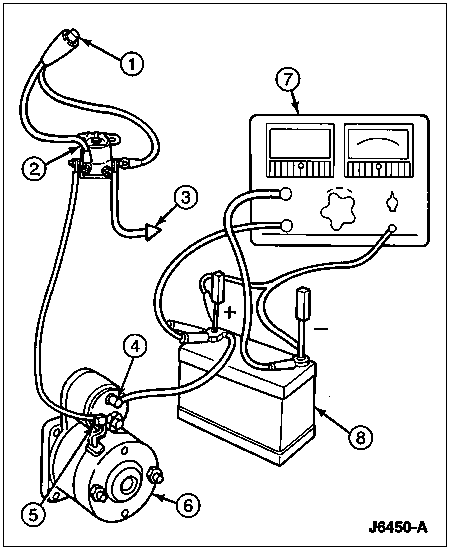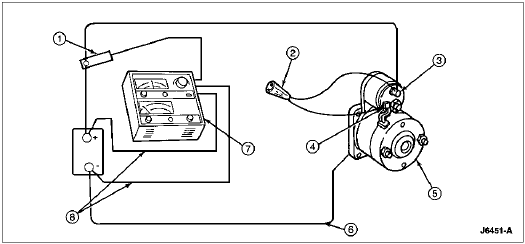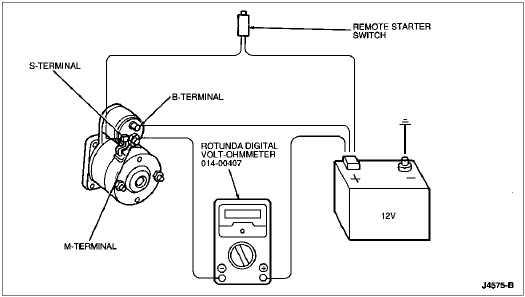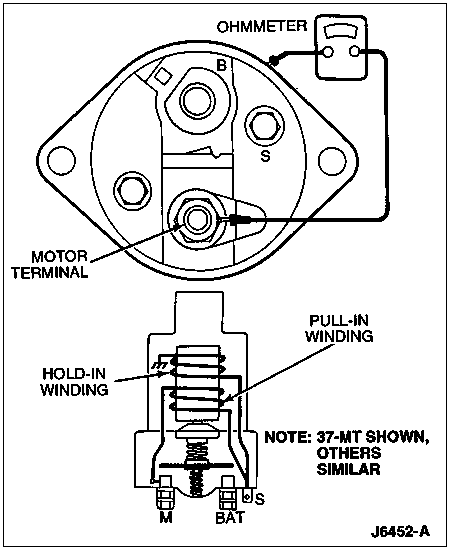Section 03-06: Starting System | 1996 F-Series and Bronco Workshop Manual |
DIAGNOSIS AND TESTING
Component Tests
Starter
Load Test
Battery must be fully charged and serviceable before performing a starter load test. Refer to Section 14-00 for battery inspection and test procedures.
Set parking brake and shift transmission into neutral.
Prevent engine from starting by disconnecting wiring at fuel shutoff solenoid.
Connect Rotunda Alternator, Regulator, Battery and Starter Tester (ARBST) 010-00725 or equivalent. Make sure that current is not flowing through ammeter and heavy-duty carbon pile rheostat portion of circuit (rheostat at maximum counterclockwise position).
Connect remote starter switch across starter relay S and battery terminal.
Key to RUN.
Crank engine (6007) and determine exact reading on voltmeter.
Stop cranking engine, and reduce resistance of carbon pile until voltmeter indicates same reading as that obtained while starter motor cranked the engine. The ammeter will indicate starter current draw under load. Check this with value listed in Specifications.
Starter Motor Load Test

| Item | Part Number | Description |
|---|
| 1 | — | Remote Starter Switch |
| 2 | — | Starter Relay |
| 3 | — | To Ignition Switch |
| 4 | — | Starter Solenoid B Terminal |
| 5 | — | Starter Solenoid S Terminal |
| 6 | 11002 | Starter Motor |
| 7 | 010-00725 | Alternator, Regulator, Battery and Starter Tester (ARBST) |
| 8 | — | Battery |
Drive Pinion Test
If the overrunning clutch in the starter drive does not operate, the starter motor will engage but will not crank the engine.
The starter motor must be removed to check the overrunning clutch. Using a small pry bar, turn the drive pinion clockwise and counterclockwise. In one direction, the pinion should freewheel. In the other direction, the overrunning clutch should lock the pinion to the armature shaft. If the pinion freewheels in both directions, replace the starter drive. Refer to Section 03-06A or Section 03-06B for procedure.
NOTE: The above check can be misleading. An overrunning clutch may lock when manually rotated, but will not hold under engine cranking torque. Replace the starter drive if indicated by reasonable diagnostic procedures.
No-Load Test
Remove starter motor. Refer to Section 03-06A or Section 03-06B.
Connect a fully charged battery, a Rotunda Alternator, Regulator, Battery and Starter Tester (ARBST) 010-00725 or equivalent, and a remote starter switch to starter motor as shown in following electrical schematic.
Close remote starter switch. Pinion should shift to crank position and motor should run smoothly.
While the starter motor is running, check voltmeter and ammeter readings.
Voltage should be greater than 11.0 volts and the amperage should be no more than 70 amps.
If voltage is lower than specified voltage, or amperage is higher than specified amperage, refer to following chart to determine cause and corrective action. If action to take requires starter disassembly and component inspection or testing, refer to Section 03-06A or Section 03-06B.
Starter Motor No-Load Test

| Item | Part Number | Description |
|---|
| 1 | — | Inductive Pickup |
| 2 | — | Remote Starter Switch |
| 3 | — | B Terminal |
| 4 | — | S Terminal |
| 5 | 11002 | Starter Motor |
| 6 | — | Ground Connection to Starter |
| 7 | 010-00725 | Alternator, Regulator, Battery and Starter Tester (ARBST) |
| 8 | — | Voltmeter Leads |
STARTER MOTOR NO-LOAD TEST RESULTS
| TEST RESULT | PROBABLE SOURCE | ACTION TO TAKE |
|---|
| | - RECHECK battery, switches and wiring, including voltage drop tests, if cranking motor operation on engine is slow or sluggish.
|
- Current Flow with Test Circuit Switch Open
| - Solenoid contacts stuck closed.
| - TEST and, if necessary, REPLACE solenoid assembly.
|
- Failure to Operate with Very Low or No Current
| | - INSPECT and TEST solenoid assembly.
|
| | | - INSPECT and TEST frame and field assembly.
|
| | - Open armature coil(s) or high insulation between commutator bars.
| |
| | - Broken brush spring(s) or worn brushes.
| - INSPECT brushes and brush springs.
|
- Failure to Operate with High Current
| - Frozen bearing, or other damage to drivetrain.
| - INSPECT bearings, armature, driveshaft and related drive parts.
|
| | - Direct ground in terminals or fields.
| - INSPECT and TEST frame and field assembly, solenoid assembly, armatureand brush installations for shorts.
|
- Low Speed with High Current
| - Excessive friction in bushings or gear reduction unit, bent armatureshaft or loose pole shoe, bent driveshaft.
| - INSPECT bearings, armature, driveshaft, and gear reduction gears.
|
| | | - INSPECT and TEST armature.
|
| | - Grounded armature or fields.
| - INSPECT and TEST frame and field coil assembly and armature.
|
- Low Speed with Normal (or Low) Current
| - High internal electrical resistance caused by poor connections,defective leads or dirty commutator.
| - INSPECT internal wiring, electrical connections and armature commutator.
|
| | | - INSPECT and TEST solenoid assembly.
|
| | | - INSPECT and TEST frame and field assembly.
|
| | - Open armature coil(s) or high insulation between commutator bars.
| |
| | - Broken brush spring(s) or worn brushes.
| - INSPECT brushes and brush springs.
|
- High Speed with High Current
| | - INSPECT and TEST field and frame assembly.
|
Voltage Drop Tests
If the starter cranks slowly and the battery is satisfactory, there may be a malfunction of the starter or in the cranking circuit wiring. To determine if the problem is in the wiring, a voltage drop test must be performed on the following:
- motor feed circuit
- motor ground circuit
- individual cables
These tests are performed to determine if there is excessive resistance in the starter motor circuit. Always make the volt-ohmmeter connections at the component terminal rather than at the cable wiring end connector. Making a connection at the wiring end connector could result in false readings because the meter will not pick up a high resistance between the wiring connector and the component.
Motor Feed Circuit
A motor feed circuit test checks all wiring and connections between battery positive terminal and starter motor for excessive resistance.
Prevent engine from starting by disconnecting wiring at fuel shutoff solenoid.
Connect a remote starter switch between starter solenoid S terminal and battery terminal.
Connect Rotunda Digital Volt-Ohmmeter 014-00407 or equivalent positive lead to battery positive (+) post. Connect Rotunda Digital Volt-Ohmmeter 014-00407 or equivalent negative lead to solenoid M terminal.
Engage remote starter switch. Read and record voltage. Voltage reading should be 0.5 volt or less.
If voltage reading is higher than this, indicating excessive resistance, move the Rotunda Digital Volt-Ohmmeter 014-00407 or equivalent negative lead to starter solenoid B terminal and repeat test. If voltage reading at B terminal is lower than 0.5 volt, concern is either in connections at the solenoid or in solenoid contacts.
Remove cables from solenoid B, S, and M terminals. Clean cables and connections and reinstall cables to proper terminals. Repeat Steps 1 through 5 above. If voltage drop reading is still higher than 0.5 volt when checked at M terminal or lower when checked at B terminal, concern is in solenoid contacts. Remove and replace starter motor or starter solenoid, if available.
If the voltage reading taken at the starter solenoid B terminal is still higher than 0.5 volt after cleaning cables and connections at starter solenoid, concern is either in positive (+) battery cable connection, or in positive battery cable itself.
By moving the Rotunda Digital Volt-Ohmmeter 014-00407 or equivalent negative lead toward battery and checking each mechanical connection point, excessive voltage drop can be located. When high reading disappears, last mechanical point that was checked is concern.
Motor Feed Circuit Voltage Drop Test

Motor Ground Circuit
A slow cranking condition can be caused by resistance in the ground or return portion of the cranking circuit. A starter ground circuit test checks the circuit between the starting motor ground and the battery negative terminal. Check the voltage drop in the ground circuit as follows.
Prevent engine from starting by disconnecting wiring at fuel shutoff solenoid.
Connect a remote starter switch between starter solenoid S terminal and the battery terminal.
Connect a Rotunda Digital Volt-Ohmmeter 014-00407 or equivalent positive lead to starter motor housing (connection must be clean and free of rust or grease). Connect Rotunda Digital Volt-Ohmmeter 014-00407 or equivalent negative lead to negative (-) battery terminal.
Engage remote starter switch and crank engine. Read and record the volt-ohmmeter reading. Reading should be 0.2 volt or less.
If voltage drop is more than 0.2 volt, clean negative cable connections at battery and body connections, and retest. If voltage drop is still too high, test individual cables.
Motor Ground Circuit Voltage Drop Test

Individual Cable
A battery cable problem can produce symptoms similar to a dead battery, bad solenoid, or weak starting motor. If the cables do not allow enough current flow, the starter will turn slowly or not at all.
Connect positive (+) lead of Rotunda 73 Digital Multimeter 105-R0051 or equivalent to battery positive (+) post. Connect negative (-) lead to starter solenoid B terminal.
To locate excessive voltage drop in cable, move multimeter negative (-) lead toward battery and check each mechanical connection point. When high reading disappears, last mechanical connection point that was checked is the problem.
Starter Solenoid
Disconnect battery negative cable.
Using a Rotunda Digital Volt-Ohmmeter 014-00407 or equivalent, check windings of solenoid assembly for continuity as follows:
- Check resistance of solenoid pull-in and hold-in windings in series by measuring resistance between motor terminal and solenoid case. Resistance should be approximately 0.95 ohms.
- An extremely high resistance reading indicates a break or fault in winding continuity. A very low resistance reading indicates a short or ground in the winding circuit. Either condition is cause for replacement of the solenoid assembly.
Starter Motor Solenoid Windings Test





